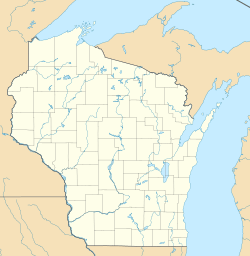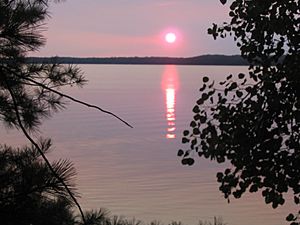Grindstone Lake (Wisconsin) facts for kids
Quick facts for kids Grindstone Lake |
|
|---|---|
| Location | Sawyer County, Wisconsin |
| Coordinates | 45°56′N 91°25′W / 45.933°N 91.417°W |
| Type | freshwater |
| Basin countries | United States |
| Max. length | approx. 3 mi (4.8 km) |
| Max. width | approx. 2 mi (3.2 km) |
| Surface area | 3,176 acres (1,285 ha) |
| Max. depth | 60 ft (18 m) |
| Water volume | 92,111.0 acre-feet (113,617,200 m3) |
| Shore length1 | 10.5 mi (16.9 km) |
| Surface elevation | 1,287 ft (392 m) |
| 1 Shore length is not a well-defined measure. | |
Grindstone Lake is a large freshwater lake in northern Wisconsin, USA. It's located in Sawyer County, Wisconsin, near the town of Bass Lake. This beautiful lake is a popular spot for visitors and cabin owners.
Contents
About Grindstone Lake
Grindstone Lake is shaped a bit like an oval. It stretches about three miles (4.8 km) from east to west and two miles (3.2 km) from north to south. The lake covers an area of about 3,176 acres (12.85 km²). It is 60 feet (18 meters) deep at its deepest point. The shoreline measures about 10.5 miles (16.9 km) long.
A small stream called Grindstone Creek flows into the lake on its east side. This stream starts from several springs nearby. Another small stream, also named Grindstone Creek, flows out of the lake on its southeast side. This outlet stream leads to Lac Courte Oreilles, another large lake.
Where is Grindstone Lake?
Grindstone Lake is located about six miles (9.7 km) southeast of Hayward. Hayward is the main town for shopping and services in the area. Grindstone Lake is one of three big natural lakes in this region. The other two are Lac Courte Oreilles and Round Lake.
On the south side of Grindstone Lake, there is a small community called Northwoods Beach. The eastern part of the lake is within the Lac Courte Oreilles Indian Reservation. Most of the lake's shore is lined with cabins and homes. Many people visit the lake during different seasons.
Visiting Grindstone Lake
There are two public places where you can launch a boat on Grindstone Lake. One is a well-maintained landing at the southwest corner. The other is a smaller, less developed landing at the southeast corner, close to the outlet stream.
Grindstone Lake is a popular vacation spot. Many cabin owners and visitors come from big cities like Minneapolis-St. Paul, Milwaukee, and Chicago. They come to enjoy the lake and its surroundings.
How Grindstone Lake Got Its Name
The name "Grindstone Lake" comes from a word in the Chippewa language. The word is Gaa-zhiigwanaabikokaag, which means "a place abundant with grindstones." Grindstones are special stones used for sharpening tools.
However, the lake hasn't always been called Grindstone Lake. In 1831, an explorer named Henry Schoolcraft traveled through this area. He called the lake "Lac du Gres," which means "Sandstone Lake" in French. The next year, in 1832, Captain James Allen joined Schoolcraft on another trip. Captain Allen made a detailed map of northern Minnesota and Wisconsin. On his map, he labeled this lake in English as "Sandstone Lake."
A Look Back: History of Grindstone Lake
Before Europeans arrived, the Ojibwe (also known as Ojibwa) Native American people lived around Grindstone Lake. The first known Europeans to visit this area were Pierre-Esprit Radisson and Médard des Groseilliers. They traveled from Lake Superior in 1659. They stayed for a while at a Native American village that was located on the nearby Lac Courte Oreilles.
Grindstone Lake was an important part of a travel route for Native Americans and early traders. This route connected different river systems. Travelers would go from Lac Courte Oreilles (part of the Chippewa River watershed). They would then pass through Grindstone Lake and Windigo Lake. From there, they would cross the Namekagon Portage to reach the Namekagon River. The Namekagon River is part of the St. Croix River watershed.
Later, in 1767, another explorer named Jonathan Carver passed through the area. He specifically traveled through what is now Grindstone Lake on June 29, 1767. Henry Schoolcraft also visited the area in 1831. He described crossing from the St. Croix River watershed to the Chippewa River watershed. He did this by going up the Namekagon River, crossing the Namekagon Portage, and passing through Windigo Lake (which he called Lac des Isles) and Grindstone Lake (which he called Lac du Gres) to reach Lac Courte Oreilles.




